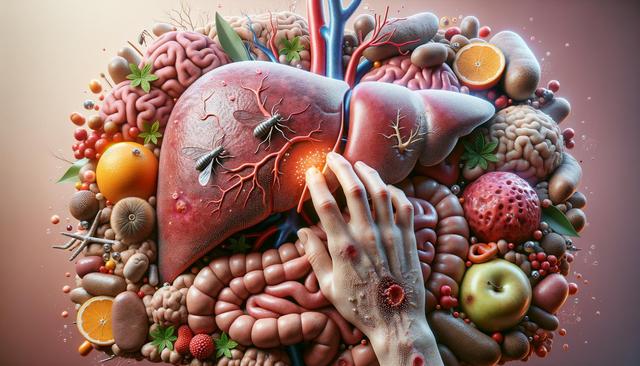The Connection Between Fatty Liver and Itching
Fatty liver disease, particularly non-alcoholic fatty liver disease (NAFLD), is often recognized for symptoms like fatigue and abdominal discomfort. However, lesser-known signs such as skin itching can also be linked to liver function. This itching, medically referred to as pruritus, can be a result of bile acids accumulating in the bloodstream when the liver is not functioning properly. In the early stages of fatty liver disease, these symptoms may be subtle or mistaken for unrelated skin conditions. Recognizing this link is crucial in identifying liver health issues before they progress.
Itching associated with fatty liver disease often affects the arms, legs, and back but can occur anywhere on the body. Unlike typical skin irritations, this type of itching usually has no visible rash or redness, making it more difficult to diagnose. It’s believed that inflammation and liver dysfunction may interfere with the body’s ability to process bile, leading to the buildup of substances that trigger nerve endings in the skin. This can be particularly frustrating for individuals who are otherwise asymptomatic or unaware of their liver condition.
Inflammation and Liver Dysfunction
Inflammation is a key factor in the progression of fatty liver disease, and it plays a significant role in the development of itching. As fat accumulates in the liver, it can cause oxidative stress and activate immune responses that lead to chronic inflammation. This inflammatory state can damage liver cells and impair bile flow, which contributes to systemic symptoms such as pruritus.
There are several mechanisms by which liver inflammation may trigger itching:
- Increased production of inflammatory cytokines
- Reduced bile flow (cholestasis)
- Accumulation of bile acids in the bloodstream
- Imbalance of neurotransmitters related to skin sensation
Understanding that itching may stem from internal inflammation rather than an external skin issue can help guide appropriate treatment. Addressing the root cause—liver inflammation—can reduce discomfort and potentially slow disease progression.
Other Hidden Signs of Fatty Liver Disease
Alongside itching, fatty liver disease may present with a variety of subtle symptoms that are often overlooked. These signs can provide important clues about liver health, especially when they occur in combination. Common hidden symptoms include:
- Persistent fatigue
- Unexplained weight gain or difficulty losing weight
- Brain fog or trouble concentrating
- Right upper abdominal discomfort
- Dark-colored urine or pale stools
These symptoms may develop gradually and can be attributed to other conditions, making early detection challenging. However, being aware of these lesser-known indicators can prompt individuals to seek medical evaluation, leading to timely diagnosis and lifestyle changes that support liver health.
When to Seek Medical Advice
If itching becomes persistent and cannot be explained by common dermatological causes, it may be time to consider liver function as a possible factor. Seeking medical advice is crucial, especially if the itching is accompanied by other symptoms such as jaundice, fatigue, or unexplained weight changes. Blood tests and imaging studies can help assess liver health and determine the presence of fatty liver disease or related conditions such as cholestasis or hepatitis.
Here are some signs that should prompt a conversation with a healthcare provider:
- Itching that worsens at night or disrupts sleep
- No visible rash or skin irritation
- Itching combined with fatigue or digestive issues
- Family history of liver disease or metabolic syndrome
Early diagnosis can make a significant difference in managing fatty liver disease. Treatments may include dietary changes, increased physical activity, and in some cases, medication to address inflammation or improve liver function.
Managing Itching and Supporting Liver Health
Managing itching caused by fatty liver disease involves both symptomatic relief and addressing the underlying liver issue. While topical creams and antihistamines may offer temporary relief, they do not resolve the root cause. The most effective approach is to support liver health through lifestyle modifications and medical guidance.
Helpful strategies include:
- Adopting a balanced diet rich in vegetables, fruits, whole grains, and healthy fats
- Reducing sugar and processed food intake
- Engaging in regular physical activity to reduce liver fat
- Avoiding alcohol and unnecessary medications that strain the liver
- Staying hydrated to support detoxification processes
In some cases, medications that bind bile acids or reduce liver inflammation may be prescribed. However, these should only be used under medical supervision. Regular monitoring through liver function tests and imaging can track progress and ensure that any worsening symptoms are promptly addressed.
Conclusion: Recognizing and Responding to Subtle Liver Symptoms
Fatty liver disease often progresses silently, with non-specific symptoms like itching providing early warning signs. While pruritus may seem unrelated to liver health, it can be a clear signal of underlying inflammation and bile imbalance. By understanding this connection and being attentive to other hidden signs of liver dysfunction, individuals can take proactive steps toward diagnosis and management. Addressing fatty liver disease early through lifestyle changes and medical support can help reduce discomfort, prevent complications, and promote long-term well-being.




Leave a Reply